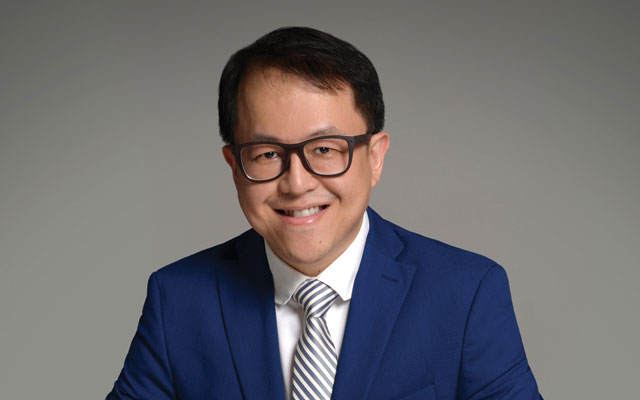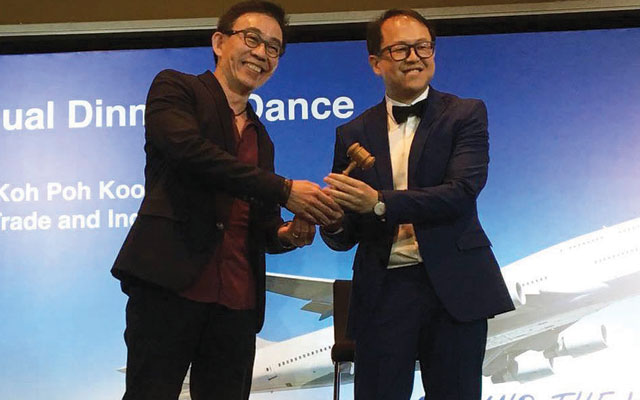Mark Yong takes over the three-decade old Singapore Furniture Industries Council in November 2016 and dives right into taking the association stronger into the future
What’s your vision for the Singapore Furniture Industries Council (SFIC)?
Our council has never been one to rest on its laurels and do the same old, same old. We’ve always had a very active Exco, and rejuvenation has always been on our minds. For an association like ours that has been around for 35 years, we have always thought of the future. We want to see ourselves as being a future-ready and smart association that is able to chart the path for our industry.
Over the years we’ve embarked on many initiatives and this will continue.

The last president, Ernie Koh, had a three I strategy – Integrate, Innovate and Improve – which has helped develop the capabilities of our members.
2016 was not a smooth-sailing year for the general economy, 2017 is a tough year and 2018 will be too. But there are new ways of doing business and new markets to explore, so we hope that SFIC can be the leading body to bring our members to new and greener pastures.
Can you share one new thing you are doing to bring SFIC forward?
Among my plans is a membership boost. Many of our members were manufacturers in the past, who have moved most of their activities out of Singapore although their headquarters remains here along with their marketing and design activities. The make-up of our association has evolved.
To expand our membership, we need to reach out to new members and those who are not contributing actively to SFIC. These include new industry clusters. Previously, we concentrated on manufacturing industry clusters. Now we are also looking at furniture manufacturers, retailers/wholesalers, designers/design studios, and materials and equipment suppliers.
Doing so helps us greatly increase the critical mass of recipients of our services, thereby allowing us to create more capability development activities and initiatives, and more opportunities for cross collaboration between members.
Of the five clusters you are targeting for membership growth, is there any one in particular that you hope to grow the most?
All five are important and they are already members. Perhaps we have fewer design members, so we hope to convey to this cluster that, hey, we are taking care of design studios that are linked to the furnishing industry, so join us and benefit from the activities we will create just for you to help you expand your network and business opportunities.
It is common to hear of associations facing difficulty attracting young members. Is it the same for SFIC?
Most of our Executive Committee members – eight or nine of them – are aged below 40, with some under 30. This is very unusual for a trade association.
This is a result of our continued efforts to attract the young. Two decades ago, SFIC started a Youth Furniture Committee to bring in second- and third-generation furniture players. These members get to participate in our activities and meet the more established players in the industry. SFIC has become a very important avenue for them to gain access to veterans.
The Youth Furniture Committee has created a constant stream of young members for us. There was never a break, a five- or 10-year lapse with nobody new joining our industry. Even up till today, we still have people in their 20s joining us, people who are second- and third-generation players or entrepreneurs.
Keeping SFIC relevant ensures that people feel it is worth their while to join us and to spend time at our activities.
Providing members a sense of belonging is also critical. Even though we have members in their 50s and 60s, newcomers still find SFIC worth their time and effort.
Does SFIC involve the younger members in bigger roles at SFIC, like strategising or activity planning?
Definitely. When you are an Executive Committee member, you have a portfolio – or even a few portfolios – to take care of.
When I joined SFIC about seven years ago, I was very quickly paired up with more experienced Executive Committee members to take charge of the green standards committee. I was also roped in to the design development committee. This sense of belonging came from being bestowed some responsibilities.
The experienced Executive Committee members are very supportive too, which helps integrate new members into the council. The younger members are encouraged to air their views and contribute something based on their background. For instance, they are the ones who showed us how to jump on the bandwagon of e-commerce and m-commerce.
We organise many bonding activities too for the new and experienced members.
And are you carrying this winning formula for membership sustainability into your leadership?
Yes, I truly believe in the drawing power of involvement. As soon as I became president, I assigned portfolios to both the Executive Committee and Co-Opt members.
Co-Opt members are those that not initiated into the 17 Executive Committee spots but are already bringing their expertise to the table. One of our Co-Opt members, for instance, is prolific designer Nathan Yong. He has been Co-Opted into our committee and is in charge of the design cluster.
Everyone, Executive Committee and Co-Opt members, must be initiated into the SFIC by being given responsibilities. Each of the five clusters have at least two members in charge – a chairman and a vice-chairman. They take ownership of SFIC projects, such as public events and awards. There are no idle Executive Committee members here.
Can you tell me more about the functions of your Youth Furniture Committee?
The Youth Furniture Committee is another way for us to engage with the greater furniture and furnishings industry in South-east Asia.
In 2015, SFIC initiated the ASEAN Youth Furniture Exchange. Through this platform we brought together all the second- and third-generation players from the furniture and furnishings industry across the region. SFIC is part of the ASEAN Furniture Industries Council. AFIC holds meetings twice a year at least.
SFIC hopes that the ASEAN Youth Furniture Exchange will be an annual event, with every edition held in a different country. The first run was in Singapore, and the second in Vietnam.
The three-day event brought together all the industry’s young and gave them an opportunity to network and create friendships, which we hope will lead to business collaborations in design, manufacturing and retail. We’ve already seen some results from this.
Who leads the organisation of the ASEAN Youth Furniture Exchange, and what sort of programme does it have?
The event is organised by the host council, and over three days attendees will visit factories, attend seminars and perhaps a city tour. Although the council in the host country will take the lead, all councils will come together to talk about content, and share ideas to shape the itinerary.
The event still has a very organic procedure. There isn’t a formal process yet, not even in the destination selection. The event went to Vietnam last year because the council there offered to take it on. There isn’t a formal bidding process yet.
This is unlike the AFIC meetings which rotate around the region by alphabetical order.
Let’s talk about your SMART SFIC initiative, which is another part of your new strategic direction for SFIC.
The buzzword today is disruption. Many industries are being disrupted by technology and it is the same for ours. We want to educate our members through a more concerted effort and let them know that disruption is not scary. It is something that can help their business and is something they should embrace.
The SMART SFIC initiative hopes to create e-commerce and m-commerce platforms for our members to use, to market or sell their products and services, and educate members on
what’s available out there and how to use them.
For example, we could encourage members to use 3D printing or modelling, or virtual or augmented reality in their presentations.
A smart furniture industry also needs to study future issues. For instance, there are ageing and space issues here in Singapore. How will our industry players use technology, new methods of design, or new products to enhance their offerings for a new breed of users? In Singapore, where living space is getting smaller, people may need transformable furniture – not the usual sofa bed, but something that is truly designed for a smaller home.
We could also have IoT-embedded furniture that could help monitor the elderly or the handicapped.
We hold occasional seminars and talks that address current hot topics, and these platforms are used to tackle the topic of technology in the furniture industry.
How often are your educational events conducted?
The frequency and topics of these seminars and talks depend on the availability of an expert speaker. Often they are held during our main events, like SingaPlural and International Furniture Fair Singapore. Throughout the year we also have collaborations with DesignSingapore Council or A*STAR (Agency for Science, Technology and Research) to conduct seminars like these.
In October 2016, we had a study mission to Japan involving eight to 10 companies to learn about the smart furniture industry there, and see how office space is used, how nursing homes are designed, etc.
Besides these events, SFIC also supports our members by leading them to major exhibitions overseas – at least three a year – where we will have a Singapore pavilion. We get financial assistance from International Enterprise Singapore through its International Marketing Assistance Programme.
Let’s talk about the new home for SFIC. How will this benefit SFIC’s operations?
The new Furniture Hub (officially JTC Furniture Hub @ Sungei Kadut) is slated to be ready by the end of 2018. It symbolises a new era for SFIC.
Singapore is land-scarce, so a lot of the furniture-related factories and offices are in the Sungei Kadut industrial estate. That remains the home of our industry, but how do we better use the land and continue to update the image of Singapore’s furniture industry to make it relevant and attractive to younger players and even consumers?
The new home will be one big building that houses more of the future-ready furniture brands and companies from the five industry clusters.
Previously, each company had their own land and building. The plan is to move as many of them as possible into the new hub which allows us to share resources, such as material libraries, workshops, labs and meeting spaces.
The SFIC Institute and the association headquarters will also sit in the Furniture Hub. Being located together also facilitates collaboration and knowledge exchange.
The Furniture Hub will be a very self-sufficient building, with restaurants, cafeterias and atriums.
Along with the Furniture Hub, the government has announced plans to rejuvenate Sungei Kadut and bring more life and colour to it. Over the next 10 years, Sungei Kadut will be a sexy and exciting area; no longer a messy estate of factories.
Last question: what else is important for the advancement of SFIC?
Professionalising the council is very important for us. We have a strong and committed secretariat team, which has allowed SFIC to be one of the strongest industry associations in Singapore. Further professionalising our secretariat is key. We’ve studied how overseas associations run themselves, where the secretariat is the face of the entire industry. That is our goal.
SFIC should be self-sufficient and all the activities we do should generate revenue that we can use to develop even more support programmes for the industry.
SFIC cannot always be reliant on government funding although the government agencies have all been very supportive of our activities and initiatives.
Mark this leader
Mark Yong joined SFIC in 2008 and has since taken on several portfolios. He is the chairman of SingaPlural, the anchor event of Singapore Design Week, and is on the Board of Directors for the SFIC Institute.

In 2002, Yong joined Ewins, a distributor and exporter of furniture components company established in 1967. He holds the position of director, and oversees marketing and sales activities for all brands and product lines distributed by Ewins in Singapore and to the rest of Asia.
He is also a director and co-founder of UberGARD, a young company dealing with security systems for facilities management, providing unique security solutions to customers in Asia, Australia and the UK.
Yong’s passion lies in design, and although he was never formally trained in any aspect of design, he lives and breathes it in the course of his work.











